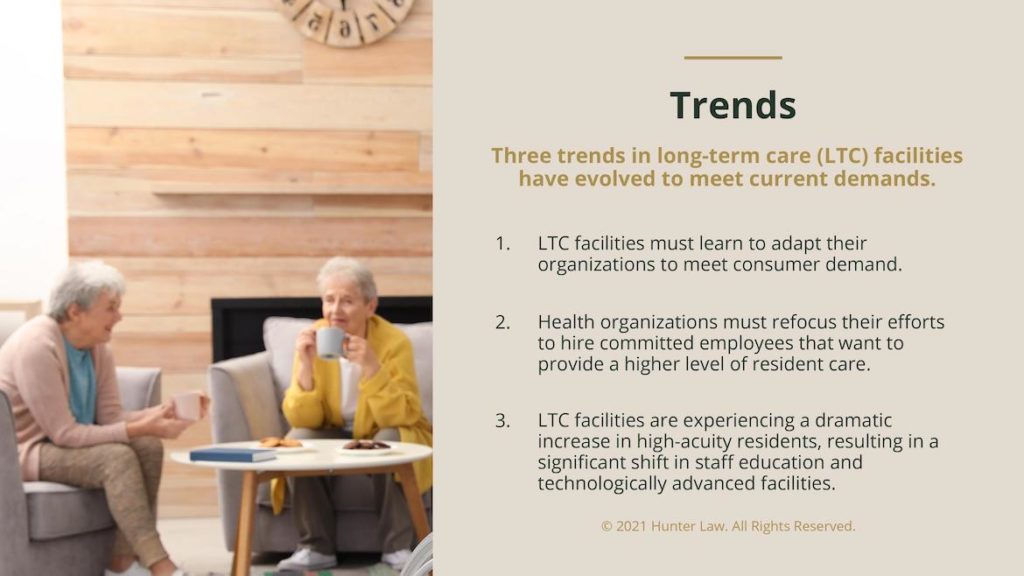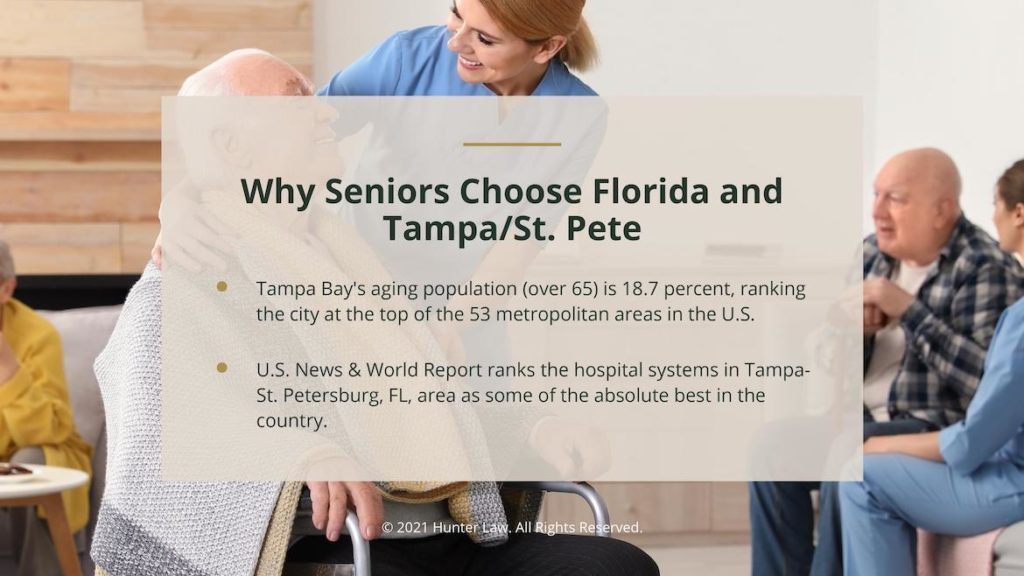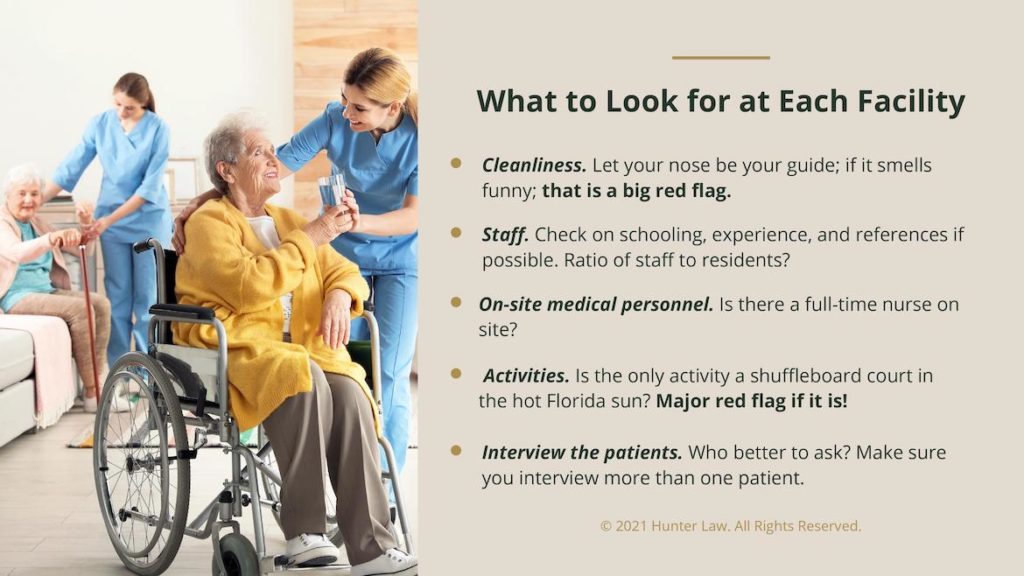Americans are getting older and wiser quickly. By 2040, the number of aged (over 65 Americans) is expected to double, reaching an astounding 80 million individuals. These statistics equal one in every five Americans, up dramatically from one in eight in 2000. Choosing a safe nursing home facility in Tampa Bay requires pre-planning and knowing what to look for.
The following post represents a robust elderly care system in the State of Florida and in particular the Tampa-St. Petersburg area. We break down a few of the trends across America, highlighting the ever-present challenges faced in a population that is increasingly getting older.
Florida represents one of the premier states in America, with every type of facility available. Tampa and surrounding areas have plenty of resources for loved ones who need increasing care as they age. We describe each type of facility and where to go for additional information.

Trends
Aging in America is much different than in years past. Three trends in long-term care (LTC) facilities have evolved to meet current demands.
- Increasing popularity among the elderly is “Aging in Place.” A report from AARP says the majority of older Americans prefer to remain in their home and Age in Place as long as possible. LTC facilities must learn to adapt their organizations to meet consumer demand.
- Long-term care facilities will remain highly competitive. Health organizations must refocus their efforts to hire committed employees that want to provide a higher level of resident care.
- LTC Facilities are experiencing a dramatic increase in high acuity residents, resulting in a significant shift in staff education and technologically advanced facilities
Challenges
Facilities are coping with residents having severe chronic diseases and illnesses, including an accelerated number of occupants with dementia and Alzheimer’s. Mortality rates have dropped, with average life expectancy increasing from 69 years in 1950 to 78.6 in 2017. (who says we do not report good news)
America’s older generation faces unprecedented obstacles; wide economic disparities, obesity rates, are just a few. Women have faced the brunt of the new aging landscape. 26 percent of women aged 65 to 74 live alone, jumping 39 percent.

Why Seniors Choose Florida and Tampa/St. Pete
According to Realtor.com, Tampa is in the top ten cities where people move to; and out of areas like New York and Detroit. Tampa has quickly become a GREAT city, with plenty of things to do and see for all the Millennials. A vibrant music scene, microbreweries, and lots of nightlife make for a thriving community.
Tampa-St. Pete is still ground zero for the elderly. In fact, Tampa Bay’s aging population (over 65) is 18.7 percent, ranking the city at the top of the 53 metropolitan areas in the U.S. The national average is 13.3 percent.
Numerous surveys, magazines, and studies give the Tampa community high marks in senior living facilities. The city ranks 2nd for activities, 10th for health care, and several surveys rate Tampa-St. Pete the best region to retire.
U.S. News & World Report ranks the hospital systems in Tampa-St. Petersburg, FL. area as some of the absolute best in the country.
Planning For Life
What are a Few of Your Up-Coming Decisions?
Can in-home care be an option? The benefit to using in-home care is the overall cost savings, and Medicare covers some of these expenses. Intangible benefits to in-home care are preserving the elderly’s dignity and allowing them a sense of freedom. In the state of Florida, relatives can be hired and paid as personal caregivers. Head to Florida’s Home Care for the Elderly to see eligibility requirements.
Cost, make sure you and your family are sitting down when receiving a quote from that “Perfect Facility in the Perfect area of town.”
According to Genworth Capital, the following is the 2020 monthly median costs for LTC living in Tampa, Florida: (again, make sure you are firmly planted in your seat)
- In-home care – Homemaker services: $4195.00
- Assisted Living – Facility: $3225.00
- Nursing home – Semi-private room: $9946.00/ Private room: $11,391.00

These are only estimates; Florida offers comprehensive services for the elderly. Be sure to visit these additional resources:
What to Look for at Each Nursing Home Facility in Tampa Bay
There are vast numbers of mistreatment in LTC facilities. Take great care when choosing a suitable facility for your loved one. If the facility and staff do not allow complete transparency, pack up the bags and move on to the next. Here are a few questions to ask and issues to watch out for:
- Cleanliness should be at the top of your list or at least in the top three. The facility may look appealing with a grand entrance and waterfalls, but that is not an indication of cleanliness. Let your nose be your guide if it smells funny; that is a big red flag.
Check patient rooms and common areas. Take a close look at the residents; are they well-groomed? Are residents wearing pajamas in the middle of the afternoon? Another Major Red Flag!
- Staff, make sure to do your homework first and check their website before visiting the complex. Check on schooling, experience, and references if possible.
What is the ratio of staff to residents? Too many patients and even the best caregiver can be overwhelmed.
Notice:
**Does the staff smile?
**Do they say hello when you walk by?
**Are they paying attention to the patients?
- On-Site medical personnel, if your loved one is going into a nursing home facility in Tampa Bay because of age or illness, additional steps need to be undertaken. Is there a full-time nurse on-site? If not, how often do they show up? What about Alzheimer’s and dementia patients? Are they equipped to handle this type of resident?
- Activities, is the only activity a shuffleboard court in the hot Florida sun? Major Red Flag if it is!
- Physical setup, does the facility look like a hospital or apartment complex? Does it make you feel at home or never want to see the place again? Can residents bring their furniture? What about security? Have there been any instances of patients wandering off?
- Interview the patients; who better to ask? Make sure you interview more than one patient.
**Do they enjoy their time?
**Do they feel safe?
**Are there plenty of options to stay busy and engaged with other residents?

A Rich Collection of LTC Facilities in Tampa
Tampa has an abundance of long-term care facilities for each stage of life. Websites, directories, and government resources provide reviews, costs, and guidance when choosing quality care.
- Nursing Homes in Tampa provide constant care for seniors who have a difficult time carrying out daily activities. If one of your family members can no longer care for themselves and regrettably have become too much of a burden, these are the types of facilities where you need to concentrate your search.
Residents in Nursing Homes often have complex medical issues and need the highest level of daily care. Nursing Homes are usually called “Respite Care” and offer short-term rehabilitative services.
ManorCare.com, by ProMedica, is an excellent resource to start your nursing home facility in Tampa Bay search. Another option, go to your health insurance, see if they can provide help.
- The need for Alzheimer’s care, on a global scale, has exploded in recent times. Alzheimer’s is an irreversible and progressive brain disorder that tragically destroys memory and thinking skills. Eventually, the person cannot carry out even simple tasks.
Directories such as “aPlaceforMom” is a terrific site for those who need these types of facilities.
- Assisted Living Communities in Tampa combine the need for individuals who require daily assistance but do not want to live in a nursing home. Assisted living promotes maximum independence and is the continuation of LTC in a residential setting.
These communities provide a host of services; housekeeping, transportation, taking medication and using the bathroom. The support is in comfortable settings, where recreational and social interaction is provided.
- Residential Care Homes cater to an individualized clientele, offering healthcare at a self-directed pace. These are usually private homes in and around the Tampa community, serving a group of seniors who receive care from in-home caretakers.
Seniors opting for this type of service typically want more privacy in a residential setting. Health care varies between homes, with some facilities providing total healthcare for their residents.
- aPlaceforMom and SeniorAdvice are excellent places to start your search in Tampa.
- Independent Living Communities are one of the most common environments for seniors. These communities include the care each of the other specialized services offers. Continuing Care Communities provide seniors a full range of services as their needs change over time.
CCRCs are usually private homes or individual apartments. These communities offer plenty of social activities and entertainment to keep residents engaged. Occupants of these communities have few medical issues and want to maintain their independence.
Medical facilities and resident care vary, per the community.
Tampa-St. Petersburg, Florida, is a great community to find the right facility for your loved ones.


